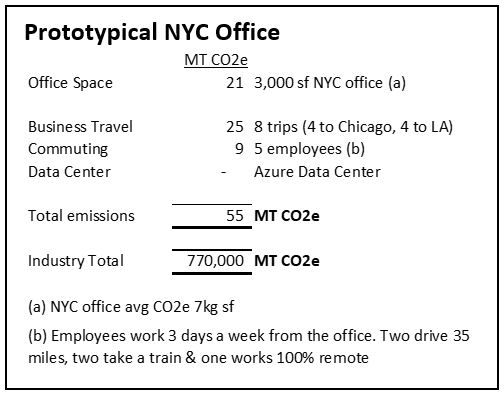Real-Life Corporate Application:
In this example scenario, there is a company with 14,000 fund managers (of which 9,500 are private equity) located in North America at the end of 2021(1). Assuming the fund managers operate in a prototypical New York City (NYC) office, they will collectively generate 770,000 metric tons of greenhouse gasses, a carbon dioxide equivalent (CO2e) per year. This amount is equivalent to driving two billion miles or burning 850 million pounds of coal(2). If managers can reduce emissions or go net-zero, it would show industry support for addressing the root cause of climate change.
Sources of Emissions
A fund manager’s greenhouse gas emissions (CO2e) are primarily from:
- Scopes 1 and 2 – Office utilities such as electricity, natural gas and steam.
- Scope 3 – Commuting, business travel and the company data center.

Going Net Zero
Going net zero means reducing a firm’s gross carbon footprint to zero by purchasing carbon credits. The cost of carbon credits varies by seller and will cost a typical office around $1,000 total. To create a net-zero firm, fund managers should follow these four steps:
- Define the boundary – What activities do you include in the calculation? Should you include just the basics like utilities, commuting, business travel and data centers or expand to incorporate taxis and HVAC refrigerants?
- Calculate your carbon inventory – Your carbon inventory is the carbon emissions within the defined boundary. Think of it as your carbon footprint.
- Establish a carbon reduction plan – Reduce firm emissions using commonly employed emission reduction strategies such as switching to energy-efficient appliances and recycled paper products for office use.
- Buy carbon credits – Buy enough carbon credits to bring the firm’s gross emissions to net-zero.
Boundary
Deciding on a boundary is a personal choice. Firms that go net-zero may initially start with emissions solely generated by their office (scopes 1 and 2 emissions) before expanding to business travel, commuting and beyond (scope 3).
Calculation
A company’s carbon inventory is calculated using various models incorporating assumptions and factors that estimate annual carbon emissions. More information on calculating carbon inventory can be found on the EPA, Energy Star, US Energy Information Administration, and the greenhouse protocol websites.
Reduction Plan
After quantifying your emissions by source, an emission reduction strategy can be implemented. Common techniques include:
- Switching office electricity to renewable energy.
- Using energy-efficient lighting with motion sensors.
- Reducing unnecessary business travel.
- Allowing remote work and reducing the size of the office.
No one strategy works best for everyone, but all of them will reduce the need to buy carbon offsets and may also reduce your overall energy and occupancy costs.
Carbon Credits
Carbon credits are generated by firms selling their carbon deficient. Examples of activities that create carbon deficiencies include planting trees, sustainable farming, renewable energy and waste management projects. Verified credits are sold on an exchange or by carbon brokers. There are numerous firms of every size selling credits as a broker or an exchange.
An example of a US-centric firm that sells carbon credits is Nori LLC. Nori buys carbon credits from US farmers at $15 per ton and sells them at cost plus a 15% commission. The US farmer gets paid for practicing sustainable farming, and the investment manager buying the credits supports a specific US farmer. Wall Street supporting US farmers could not provide a better narrative.
Conclusion
Investment managers can show support for efforts that address climate change by reducing or going net-zero themselves. A firm that is net-zero shows the world you care about global warming. Investors appreciate the effort; your community enjoys clean air, and your children will thank you for a better future.
(1) Preqin database: https://www.preqin.com/
(2) EPA Greenhouse Gas Equivalencies Calculator: www.epa.gov/energy/greenhouse-gas-equivalencies-calculator
Contact Us
Join thirty of the world’s largest investors as they reduce their carbon emissions and head towards net-zero! Reach out to us to get started today.



